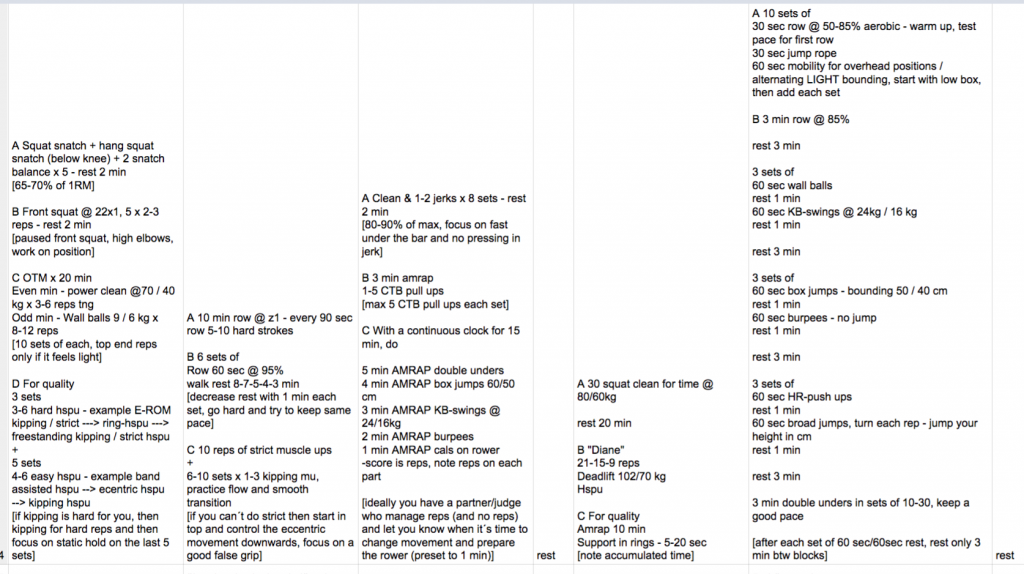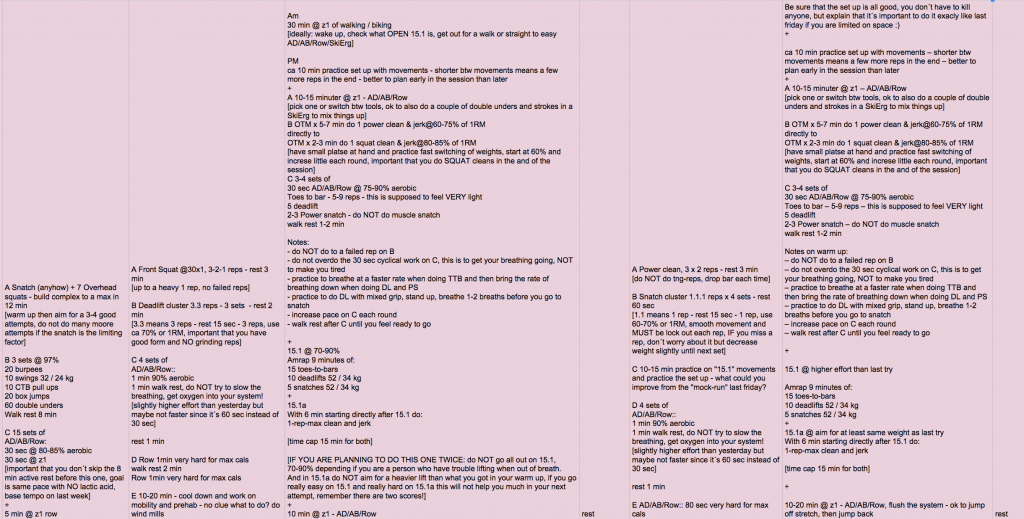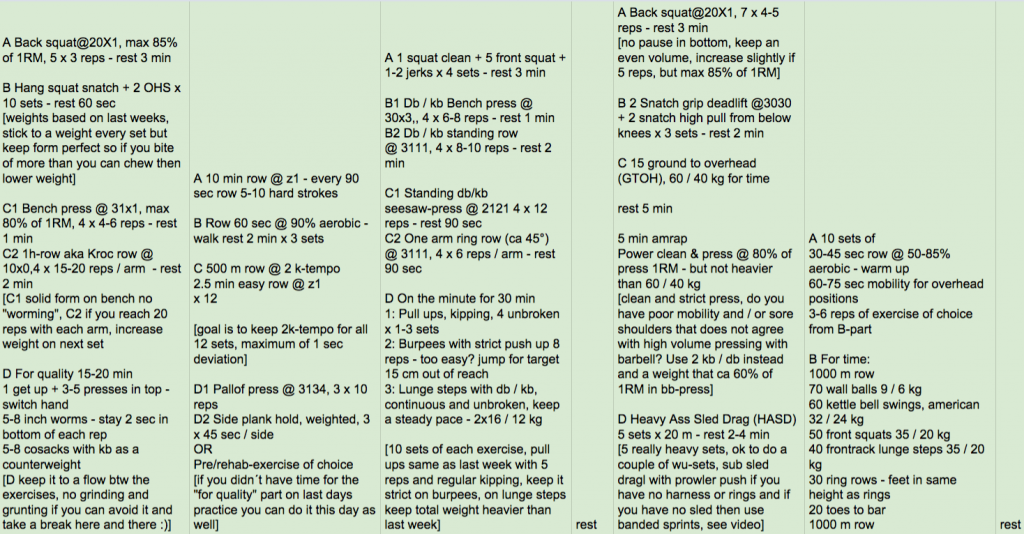FAQ
Priority training
Upper Body Priority or Lower Body Priority and ”plus” (+) in the back end of the session
Since post-OPEN 2016 we have a Upper Body Priority (UBP) or Lower Body Priority (LBP) option on FOCUS 3 training days a week. The need for this is depending on how the group evolves, right now (17-04-21) this is not needed in the FOCUS program but might be later in the training year.
The basics of this system
- Everybody does the base.
We have 5 training days and on the 3 UBP/LBP days you do all the parts of the session BEFORE theUBP/LBP-parts. Even if you got a great base, there´o no excuse to skip parts. Of course depending on aches and injuries from the past, let us know! - The priority depending on what you need to focus on.
We have some guide-lines that we can discuss but basically:
-If you are lagging upper body strength compare to lower body, then focus on“Upper body priority” (UBP)
-And the other way around if you are lagging lower body strength, focus on“Lower body priority” (LBP)
You can do both parts if you are balanced and / or you have the time, read more below. - Do at least 3 sets, up to 5 sets on priority.
Priority can mean that you focus more volume (more sets, progression from one week to the next) on one part and lower volume on the other. For example:
-If you know you are lagging upper body strength, for example strict pull ups and HSPU is a weakness, you should always prioritize UBP, so do not do fewer sets of this part to be able to find time for LBP or other parts in the end of the session. This is your focus! - You can do both UBP and LBP.
If you are pretty well balanced (to know if you are, discuss with us), then you can do both parts 3-5 sets. Ok to do both parts if you are not balanced BUT remember to ALWAYS prioritize the part that is lagging (see above) if you don´t have enough time.
And as I wrote above, email us and we´ll discuss guidelines. - Plus-parts (+) – for quality or goat practice
Like before this is depending if you got the time. First of we need to build the base and UBP/LBP of the sessions.
For quality is focused on prehab/rehab
Goat practice is tech-work that YOU need to work on, for example getting a few meters of handstand walking or doing 20+ unbroken Double unders.
Recovery Priority – instead of the regular training session
This is an alternative 2 times a week and is for you who for what ever reason is having a rough training week but still want to training 5 times. Why you are sore or having a crappy week could be from a number of reasons, night shift-work, sick kids, lots at work, injured or other reasons. It was adopted early in 2017 for the first time and as of now (17-04-21) still is an option in the training week.
Questions? Email us at info@nextlevelfitness.se
Example of a training week from FOCUS
We get a lot of questions of how the training looks like if you follow FOCUS. We have 5 times a week 60-90 min sessions and not doubles except when it´s testing. You can have a full time job, kids or other obligation and still being able to follow FOCUS. If you for some reason can´t train 5 times a week, have the discussion with us and we´ll help you out with finding the correct focus to maintain fitness or progress it.
What the focus is depends on where we are in the season. Off-season means more strength work and aerobic work and if it is In-season it will be more speed work and anaerobic work with more and more sport-specific sessions. Below are some examples of sessions during a week on different times of the season:
1. If it´s 5 weeks before the OPEN-season we will do less strength progressions and more OPEN-style amraps, example of a weeks TRAINING sessions with a couple of testers mon-sun:
2. Here´s an example of a OPEN week, this particular week is before 15.1+15.1a wed-tues. Remember that the OPEN was announced thurs night (in Sweden). Fri-mon is designed to get the most of 15.1+15.1a, remember this is TESTING (game time!) and preparation for testing and not training:
3. Here´s a couple of examples of a training week 6-8 weeks after the open. Focus is strength gains and aerobic base. Oly is maintained and volume accumulated with touches of testers to see that we are still improving at the sport of fitness. Note that these weeks are from post-OPEN from different your. The differences in the program is DUE TO TESTING OF THE GROUP.
What the hell does 30X0 mean?
It signifies a certain tempo, common tempos are 20X1, 30X0, 1111 just to name a few.
For example, if a movement has tempo @ 30X0, it means that from the top of the movement, you should take 3 sec to reach the end point of the exercise, here the bottom of the squat. The first number signifies the lowering portion of ANY exercise.
The second number signifies if there is any PAUSE in the bottom position. Because this example says 0, it means that it is simply 3 seconds down, 0 pause, and then back up. If the tempo was 31X0, then you would have to pause for 1 second at the bottom of the movement.
The third number signifies the time in which to raise the load. When it says “X” as the third number, it means to accelerate the load as fast as possible – regardless of how fast the weight is actually moving, INTENT to accelerate is most important thing here. If the number is 1111 as is common with hanging shoulder retraction then you have to take 1 seconds to lower fully, 1 sec pause in the full stretch position, then take 1 seconds to come back to the top (you are capable of going faster, but that is not what is being asked, so follow the numbers), with 1 sec active hang in top before going into the next rep.
The last number, as you may have guessed, signifies any pause at the top of the movement. If it says 30X1 for a weighted chin-up (or pull-up, same thing), then you have to hold your chin over the bar for one second before lowering for 3 seconds to full arm extension.
Note that there is also a case when you could be asked to do a 3010 tempo – on the squat for example (because it is simple). When it says 3010, the third number is critical, because it means that for whatever the rep range is, you MUST take the rx’d time to raise the load, which would be 1 second in this example. This type of tempo does NOT allow for maximal efforts within sets, as you HAVE TO MAINTAIN a certain cadence for the reps.
Also, you have to LEARN to read the number, then apply it to the given exercise. Chin-ups, for example, are a special case, the movement begin with the raising portion first – the third number, not like a back squat.
Why do we Rx tempos? Simple, it´s to control what we want you to get out of a certain session, there´s a HUGE difference between the tempos 30×0, 5121 and 1111. So please follow the tempo! 🙂
OTM, ESM, CTB, BB, DB and such – wtf!
Ok, this is just a short for something, calm down, and makes it faster to communicate. We can´t list them all here, so be sure to ask, but here are some of them:
Amcap = as many cals as possible
Amlap = as many laps as possible
Amrap = as many reps / rounds as possible
Amsap = as many seconds as possible…and so on 🙂
BB = BarBell
CTB = Chest To Bar – commonly in pullups
COVP = Chin Over Vertical Plane – also in pull ups
DB = DumbBell
FLR = Front Leaning Rest
ESM = Every Second Minute – as OTM but in a time span of 2 minutes
ETM = Every Third Minute
LBP = Lower Body Priority
OTM = On The Minute – do a certain amount of work, then rest the remaining time of the minute, then back at it for as long as prescribed
STOH = shoulder to over head (often anyhow)
UBP = Upper Body Priority
Repetitions – What weight do I start at for each exercise of the workout, when do the warm up stop and the work out begin?
A1 High Bar Back Squat @ 20X1, 5 x 2 reps – rest 2 min
A2 Chest to Bar Chin-ups, AMRAP x 5 sets – rest 2 min
+
4 rounds of
KB swings, 21 reps, unbroken – 32 / 24 kg
Ring Dips 12 reps
Here you must consider the back squat and for some of you the kb swing. In the first part, A1-2, the key is that you MUST not fail! Sometimes there will be a prescribed weight, lets say 90%. But if you had a shitty night sleep, coming back from injury and have hard time calculating from old PRs then just remember that ju must get 2, preferably heavy, reps. For the next part with swings and dips you must consider where you are at strength wise. These will be weights and movements that you SHOULD be able to do if you want to follow the program. Here the key is UNBROKEN, it should be a weight that you can do each round unbroken x 21 reps, the dips can be fractioned as needed.
How should I load the reps if the workout calls for 5-5-5, 4-3-2-1 or 1RM?
Depends on the workout
If the workout is:
– Back squat 5-5-5-5-5 – rest 3 min
In these workouts, you warm-up to challenging load for 5 reps of the given exercise. Increase load each set if it feels good, but be sure to get a decent volume and not 4 easy sets + a max attempt.
If the workout is:
– Deadlift, 5-4-3-2-1 – rest 4 min
This is also NOT for a 1RM session. Each set is supposed be VERY challenging
If the workout is:
– Press 1 RM, take your time – rest 2-5 min btw attempts
You are being asked to find a 1RM, your best possible lift. There are lots of different strategies and thoughts on this, you will also need to ramp up differently for different movements, but key is that you get ONE good shot at 1RM in the given session
Clusters – 2.2.2 – did you get stuck on the keyboard or what?
Nope, the example above: 2.2.2 means that you in a set do a total amount of 6 reps but with 10-20 sec rest btw each 2 repetitions. Like this:
Back squat 2.2.2 reps x 4 sets = 2 reps, unrack weight, 2 reps, unrack weight, 2 reps, done with the set! Pick up weight and start the next 2 reps within 20 sec, sometimes we want shorter rest btw the repetitions but this will be clear in the description of the session
What is @ Z1 and what about 80% aerobic and 95% anaerobic?
- Aerobic means work WITH oxygen – if in intervals, repeatability is key, see below
- Anearobic means work WITHOUT oxygen – also closely connected with lactic acid
Z1 is about 50-65% intensity. That is LOW intensity, and you should get sweaty but not much more and you should be able to talk the entire session. Think a walk with a friend! This is also aerobic but very easy work.
If it says to row 400m @ 80 % x 8, with 2 min rest btw sets this means that the work times should be consistent. They should NOT be continuously slower and slower. You are being asked to show accuracy in your intensity of rowing effort. This will be much easier on a rower than if you for exemple run, as it gives second by second feedback. Sometimes you will be asked to do a @ 90% effort, this a harder pace and will also be harder to maintain, but times each set should be consistent. Repeatability is a big factor in aerobic work!
For anaerobic work the ”easiest” effort is 95% effort, this is very very hard, but if you for example row 8 sets x 20 sec @ 95% – rest 2:40, you are still meant to reach approximately the same amount of meters each set. You might also be asked to do 95% then 97% then all out! In these sessions you must TRY to give more each sessions, afterwards we will know if you also were able to go faster, same or slower each set and analyze the result. It is not uncommon to feel numb in your limbs and a bit dizzy since oxygen is mostly directed too your vital parts in hard anaerobic sprint and then the lactic acid builds up in your system. It is possible to train to be able to handle the lactic acid better but it is really important to do it with aerobic work in other sessions as well!
Scaling and substitutions
The best thing is to try to have an environment with all necessary equipment but we all the to change some things from time to time. Here are some examples:
Barbells – If you only have access to dumb bells, use ca 66% of the weight that you where supposed to do with a BB– both DB’s added together. DB usually are harder due to instability.
Bench Press – If you do not have access to a bench press, then you can use bar dips as sub.
Box Jumps – This is a fast plyometric movement, instead of a box jump you can do a standing broad jump a certain length or make a spot on the wall and jump and touch it.
Chin-ups – For example fairly heavy kb swings
Chin-ups (strict) – Negative chin-ups for the same amount of reps are an option. If you can do them, but not as well as needed, then do what you can, but ensure you take your sweet time with the lowering portion, this will make you stronger in the long run.
Chest to bar Chin-ups – If you can do regular kipping chin-ups then try to do COVP pull ups, this will make you better pulling close to the bar
Dips – a heavy pressing movement, see bench press OR a hard push up variation
Double Unders – There is no acceptable substitution for competition, sorry, learn them! BUT if you don´t have a rope then you can do jumping jacks
Front Squat – If you cannot do a front squat, do goblet squats and work on your flexibility
Wall Balls – If you don’t have access to a medicine ball to do the wall balls, then do DB thrusters. Using the same amount of weight PER hand as the rx’d weight for the wall balls.
These are just some suggestions, be sure to ask if you are uncertain!
What if I miss one or more days – which days should I prioritize?
The day after rest day is where we are doing what we consider the most important work, and from there on dropping in order. So if you only can train one out of two days just pick the one that came earlier in that microcycle relative to the previous rest day.
If you really want to get a bit of the action from multiple days (ie combining training days) you can choose to do so by either doing them as ”AM” and ”PM” sessions, with at least 4-6 hours of rest inbetween or you can reduce the volume by taking out movements closer to the end of the workout and/or just complete half of the sets/time for the individual parts. This can be hard to follow so if we would give you an general advice it would be to just do one day following the ”closest to previous rest day”-rule of thumb.
Profile picture, social media & hashtags – what to use?
#nextlevelfitnessFOCUS




0 kommentarer på “FAQ”